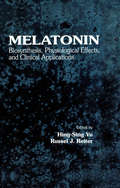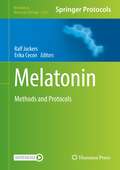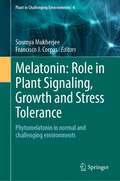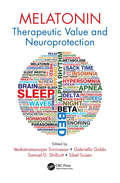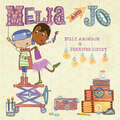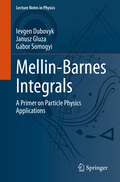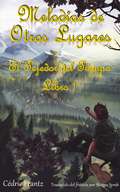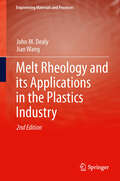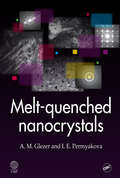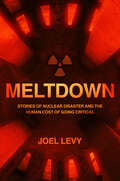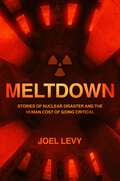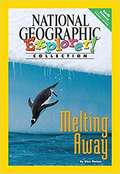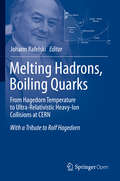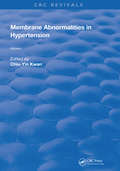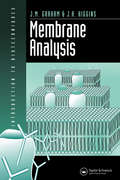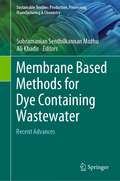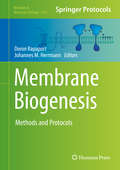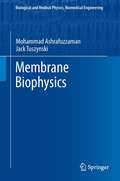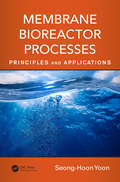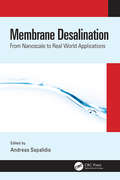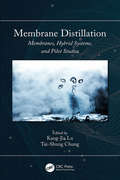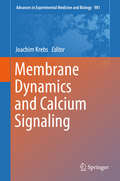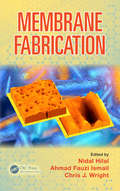- Table View
- List View
Melatonin: Biosynthesis, Physiological Effects, and Clinical Applications
by Russel J. Reiter Hing-Sing YuMelatonin: Biosynthesis, Physiological Effects, and Clinical Applications provides a thorough review of recent advances in major areas of melatonin research. The book is arranged in a logical sequence, beginning with the history of melatonin and then proceeding to cover its biochemistry and secretion, physiological effects, and clinical significance. New findings and current concepts are emphasized, and a significant amount of previously unpublished data are included. The book will be an important reference for neurobiologists, cell biologists, ophthalmologists, endocrinologists, neuroendocrinologists, reproductive biologists, psychiatrists, and other researchers and clinicians interested in melatonin.
Melatonin: Methods and Protocols (Methods in Molecular Biology #2550)
by Ralf Jockers Erika CeconThis volume covers the latest techniques that study the synthesis of melatonin, its receptor function, and its effects at the cellular and systemic level. The chapters are organized into three parts. Part One describes methods for the detection of melatonin and its biological derivatives in various biological samples, the manipulation of melatonin synthesis by the pineal gland in animals, and the principal source of melatonin in mammals. Part Two explores methods to measure the biological effects and consequences of melatonin binding to high-affinity G protein-coupled receptors. Part Three describes methods to measure the physiological effects that are regulated by melatonin in animals, particularly in rodent models. Written in the highly successful Methods in Molecular Biology series format, chapters include introductions to their respective topics, lists of the necessary materials and reagents, step-by-step, readily reproducible laboratory protocols, and tips on troubleshooting and avoiding known pitfalls.Cutting-edge and thorough, Melatonin: Methods and Protocols is a valuable resource for any researcher interested in investigating melatonin, from its production to its mechanisms of action and systemic effects.
Melatonin: Phytomelatonin in normal and challenging environments (Plant in Challenging Environments #4)
by Francisco J. Corpas Soumya MukherjeeThe new edited volume on phytomelatonin and its diverse roles in plants under a challenging environment shall be an important reference book with updated information and future perspectives on the involvement of this biomolecule in stress resilience in plants. Investigations on different aspects of melatonin in plants have undergone a prolific surge in the last decade. In view of such a considerable volume of investigations in melatonin, the proposed new volume will collate its role in different aspects of plants signaling, growth and metabolism. In this context, it has been important to understand its function as a stress priming molecule that executes associative synergistic relation with various other plant growth regulators (viz. nitric oxide, hydrogen sulfide, inorganic ions, and enzymes). Thus, crop management under diverse stressful environments can be better achieved by elucidating our current understanding of the role of melatonin and its interplay with various plant metabolites. The book shall provide a collation of recent advancements in genomic, transcriptomic, and metabolomic approaches to decipher the molecular mechanisms of melatonin signaling and its agronomic importance in plants.
Melatonin: Therapeutic Value and Neuroprotection
by Samuel D. Shillcutt Venkatramanujan Srinivasan Gabriella Gobbi Sibel SuzenThere is growing interest in the field of melatonin research regarding its neurobiological mechanisms as well as its repercussions in clinical practice. Melatonin: Therapeutic Value and Neuroprotection explores melatonin's neuroprotective effects and discusses the therapeutic potential of melatonin and melatonin agonists in treating neurodegenerati
Melia and Jo
by Billy AronsonMelia and Jo will be to STEAM what Rosie Revere is to STEM. Melia is scientific and loves to create things in her backyard laboratory, but something is missing. Her inventions just aren&’t quite right. Enter Jo, her new friend with an artistic spirit. When you add the arts to sciences, something magical happens! This whimsically illustrated picture book is the perfect introduction to the benefits of STEAM-focused curriculum.
Mellin-Barnes Integrals: A Primer on Particle Physics Applications (Lecture Notes in Physics #1008)
by Ievgen Dubovyk Janusz Gluza Gábor SomogyiIn this book, the authors discuss the Mellin-Barnes representation of complex multidimensional integrals. Experiments frontiered by the High-Luminosity Large Hadron Collider at CERN and future collider projects demand the development of computational methods to achieve the theoretical precision required by experimental setups. In this regard, performing higher-order calculations in perturbative quantum field theory is of paramount importance. The Mellin-Barnes integrals technique has been successfully applied to the analytic and numerical analysis of integrals connected with virtual and real higher-order perturbative corrections to particle scattering. Easy-to-follow examples with the supplemental online material introduce the reader to the construction and the analytic, approximate, and numeric solution of Mellin-Barnes integrals in Euclidean and Minkowskian kinematic regimes. It also includes an overview of the state-of-the-art software packages for manipulating and evaluating Mellin-Barnes integrals. The book is meant for advanced students and young researchers to master the theoretical background needed to perform perturbative quantum field theory calculations.
Melodías de otros lugares: El tejedor del tiempo - Libro 1
by Cédric FrantzEl equinoccio de primavera se acerca y el invierno está llegando a su fin en Jantival. Kalaen, de once años, lleva una vida ejemplar en su casa familiar. Apasionado por la ciencia y la música, descubre talentos innatos: tiene una percepción inusual del mundo que le rodea. Sus dones extrasensoriales incluso lograron impresionar a su vecino, el anciano alquimista y mago Falchron. Kalaen le tiene un respeto especial y secretamente desea seguir sus pasos. Durante una expedición en el bosque, hace un encuentro inusual y trae a la aldea un objeto misterioso. Con Falchron, intentan entonces desvelar los secretos de esta reliquia que parece datar de tiempos inmemoriales. ¿Cuál es la función de este extraño artefacto? ¿Lograrán descubrirlo? ¿Descubrirán las memorias del tiempo o escucharán el presagio de su fin?
Melt Rheology and its Applications in the Plastics Industry
by Jian Wang John M DealyThis is the second edition of Melt Rheology and its Role in Plastics Processing, although the title has changed to reflect its broadened scope. Advances in the recent years in rheometer technology and polymer science have greatly enhanced the usefulness of rheology in the plastics industry. It is now possible to design polymers having specific molecular structures and to predict the flow properties of melts having those structures. In addition, rheological properties now provide more precise information about molecular structure. This book provides all the information that is needed for the intelligent application of rheology in the development of new polymers, the determination of molecular structure and the correlation of processability with laboratory test data. Theory and equations are limited to what is essential for the use of rheology in the characterization of polymers, the development of new plastics materials and the prediction of plastics processing behavior. The emphasis is on information that will be of direct use to practitioners. Extensive references are provided for those wishing to pursue certain issues in greater depth. While the primary audience is applied polymer scientists and plastics engineers, the book will also be of use to postgraduate students in polymer science and engineering and as a text for a graduate course.
Melt-Quenched Nanocrystals
by A. M. Glezer I. E. PermyakovaMelt quenching-the method of quenching from the liquid state-provides new opportunities for producing advanced materials with a unique combination of properties. In the process of melt quenching, attainment of critical cooling rates can produce specific structural states of the material. Nanocrystalline materials produced by melt quenching are clas
Meltdown: Stories of nuclear disaster and the human cost of going critical
by Joel LevyMeltdown investigates and recreates the dramatic events behind the most notorious nuclear accidents in history, as well as those shrouded in secrecy. Combining human tragedy with intriguing science, each account reveals new aspects of humanity's complex relationship with nuclear power and the ongoing struggle to harness and control it. From the pioneers of Los Alamos who got up close and personal with the cores of atomic bombs, to the hapless engineers in Soviet fuel-processing plants who unwittingly mixed up a disaster in a bucket, and from the terrifying impact of a tsunami at Fukushima to the mystery of the recent Russian incident, Meltdown explores the past and future of this extraordinary and potentially lethal source of infinite power.
Meltdown: Stories of nuclear disaster and the human cost of going critical
by Joel LevyMeltdown investigates and recreates the dramatic events behind the most notorious nuclear accidents in history, as well as those shrouded in secrecy. Combining human tragedy with intriguing science, each account reveals new aspects of humanity's complex relationship with nuclear power and the ongoing struggle to harness and control it. From the pioneers of Los Alamos who got up close and personal with the cores of atomic bombs, to the hapless engineers in Soviet fuel-processing plants who unwittingly mixed up a disaster in a bucket, and from the terrifying impact of a tsunami at Fukushima to the mystery of the recent Russian incident, Meltdown explores the past and future of this extraordinary and potentially lethal source of infinite power.
Meltdown: Stories of nuclear disaster and the human cost of going critical
by Joel LevyMeltdown investigates and recreates the dramatic events behind the most notorious nuclear accidents in history, as well as those shrouded in secrecy. Combining human tragedy with intriguing science, each account reveals new aspects of humanity's complex relationship with nuclear power and the ongoing struggle to harness and control it. From the pioneers of Los Alamos who got up close and personal with the cores of atomic bombs, to the hapless engineers in Soviet fuel-processing plants who unwittingly mixed up a disaster in a bucket, and from the terrifying impact of a tsunami at Fukushima to the mystery of the recent Russian incident, Meltdown explores the past and future of this extraordinary and potentially lethal source of infinite power.
Meltdown: Stories of nuclear disaster and the human cost of going critical
by Joel LevyMeltdown investigates and recreates the dramatic events behind the most notorious nuclear accidents in history, as well as those shrouded in secrecy. Combining human tragedy with intriguing science, each account reveals new aspects of humanity's complex relationship with nuclear power and the ongoing struggle to harness and control it. From the pioneers of Los Alamos who got up close and personal with the cores of atomic bombs, to the hapless engineers in Soviet fuel-processing plants who unwittingly mixed up a disaster in a bucket, and from the terrifying impact of a tsunami at Fukushima to the mystery of the recent Russian incident, Meltdown explores the past and future of this extraordinary and potentially lethal source of infinite power.
Melting Away, Pioneer Edition (Explorer Books)
by Glen PhelanNIMAC-sourced textbook <P><P>Learn about why the Earth is heating up and how people can slow the global warming.
Melting Hadrons, Boiling Quarks - From Hagedorn Temperature to Ultra-Relativistic Heavy-Ion Collisions at CERN
by Johann RafelskiThis book shows how the study of multi-hadron production phenomena in the years after the founding of CERN culminated in Hagedorn's pioneering idea of limiting temperature, leading on to the discovery of the quark-gluon plasma -- announced, in February 2000 at CERN. Following the foreword by Herwig Schopper -- the Director General (1981-1988) of CERN at the key historical juncture -- the first part is a tribute to Rolf Hagedorn (1919-2003) and includes contributions by contemporary friends and colleagues, and those who were most touched by Hagedorn: Tamás Biró, Igor Dremin, Torleif Ericson, Marek Gadzicki, Mark Gorenstein, Hans Gutbrod, Maurice Jacob, István Montvay, Berndt Müller, Grazyna Odyniec, Emanuele Quercigh, Krzysztof Redlich, Helmut Satz, Luigi Sertorio, Ludwik Turko, and Gabriele Veneziano. The second and third parts retrace 20 years of developments that after discovery of the Hagedorn temperature in 1964 led to its recognition as the melting point of hadrons into boiling quarks, and to the rise of the experimental relativistic heavy ion collision program. These parts contain previously unpublished material authored by Hagedorn and Rafelski: conference retrospectives, research notes, workshop reports, in some instances abbreviated to avoid duplication of material, and rounded off with the editor's explanatory notes. About the editor: Johann Rafelski is a theoretical physicist working at The University of Arizona in Tucson, USA. Bor n in 1950 in Krakow, Poland, he received his Ph. D. with Walter Greiner in Frankfurt, Germany in 1973. Rafelski arrived at CERN in 1977, where in a joint effort with Hagedorn he contributed greatly to the establishment of the relativistic heavy ion collision, and quark-gluon plasma research fields. Moving on, with stops in Frankfurt and Cape Town, to Arizona, he invented and developed the strangeness quark flavor as the signature of quark-gluon plasma.
Membrane Abnormalities In Hypertension (Routledge Revivals #1)
by Chiu-Yin KwanFirst Published in 1989, this two-volume set offers a full insight into membrane abnormalities during a state of hypertension. Carefully compiled and filled with diagrams, references and information this set is recommended for students of medicine and other professionals in their respective fields.
Membrane Analysis
by Dr John Graham Joan HigginsMembrane Analysis provides a comprehensive review of laboratory methods for membrane study, with an emphasis on isolating membranes, analysing their composition and architecture, and investigating membrane function.
Membrane Based Methods for Dye Containing Wastewater: Recent Advances (Sustainable Textiles: Production, Processing, Manufacturing & Chemistry)
by Subramanian Senthilkannan Muthu Ali KhadirThis book highlights recent findings of membrane - based dye removal methods along with the application of photocatalytic, nanofiltration and ultrafiltration membrane including membrane – based fibers, metal-organic frameworks, polyethersulfone, ceramic, etc. Among water and wastewater pollutants, dyes have been normally observed and detected in various aquatic solutions, including rivers and lakes. Aesthetic pollution, toxicity, persistent, and carcinogenicity are some of the adverse effects of dyes entering the ecosystem. Although dyes have brought a colourful world, their presence in the environment are responsible for adverse effects on the planet. Diverse physical, chemical and biological methods are available to treat dye contaminated water. This book presents membrane separation technology that has been developed in the past decade to treat different wastewaters, and owning to its effective performance, has garnered the attention of academia and industry alike.
Membrane Biogenesis: Methods and Protocols
by Johannes M. Herrmann Doron RapaportMembrane proteins and membrane lipids form complex interactive systems that are highly dynamic and able to be studied only by combinations of different in vivo and in vitro techniques. In Membrane Biogenesis: Methods and Protocols, experts in the field present a broad collection of methods to study the biogenesis and function of cellular membranes. Beginning with how membrane lipids or membrane proteins can be studied, this detailed volume continues with sections covering different procedures to investigate the interaction of membrane proteins among each other or with membrane lipids, methods to study the biogenesis of membrane proteins and the dynamics of organelles, as well as protocols for the analyses of the functions or complex organization of membrane proteins. Written in the highly successful Methods in Molecular BiologyTM series format, chapters include introductions to their respective topics, lists of materials and reagents, step-by-step, readily reproducible laboratory protocols, and tips on troubleshooting and avoiding known pitfalls. Extensive and easily applicable, Membrane Biogenesis: Methods and Protocols provides readers with a comprehensive but still concise collection including both basic protocols of rather general application and more specialized methods for specific and novel techniques.
Membrane Biophysics
by Jack A. Tuszynski Mohammad AshrafuzzamanPhysics, mathematics and chemistry all play a vital role in understanding the true nature and functioning of biological membranes, key elements of living processes. Besides simple spectroscopic observations and electrical measurements of membranes we address in this book the phenomena of coexistence and independent existence of different membrane components using various theoretical approaches. This treatment will be helpful for readers who want to understand biological processes by applying both simple observations and fundamental scientific analysis. It provides a deep understanding of the causes and effects of processes inside membranes, and will thus eventually open new doors for high-level pharmaceutical approaches towards fighting membrane- and cell-related diseases.
Membrane Bioreactor Processes: Principles and Applications (Advances in Water and Wastewater Transport and Treatment)
by Seong-Hoon YoonGrasp the Essential Principles of Membrane Bioreactor ProcessesEvolved from the conventional activated sludge (CAS) process, membrane bioreactor (MBR) processes have become the next-generation solution for municipal and industrial wastewater treatment and recycle. Membrane Bioreactor Processes: Principles and Applications explores nearly all the th
Membrane Desalination: From Nanoscale to Real World Applications
by Andreas SapalidisThis book aims to provide details about membrane desalination processes, starting from basic concepts leading to real world implementation. Chapters cover novel research topics such as biomimetic and nanocomposite membranes, nanostructured fillers for mixed matrix membranes, advanced characterization techniques and molecular modeling. Additionally, engineering and economical aspects of desalination as well as the exploitation of green energy sources are thoroughly presented. This books targets bridging the gap between the everyday research laboratory practices with practical application demands, so that the readers gain a global perspective of all desalination challenges.
Membrane Distillation: Membranes, Hybrid Systems and Pilot Studies
by Kang-Jia Lu Tai-Shung ChungThis book aims to elaborate the basics and recent advances of membrane distillation (MD) as the same shows promise for seawater desalination and wastewater treatment. Starting with fundamentals of MD processes, including the heat and mass transfer analysis, energy evaluation and mathematical modelling, text includes engineering and molecular design of MD membranes. Various types of hybrid systems, including freeze desalination (FD)-MD, MD-crystallization (MDC), pressure retarded osmosis (PRO)-MD and forward osmosis (FO)-MD, will be discussed in this book. Further, it summarizes the future of MD from both industrial and academic perspectives along with energy sources and economic analysis.
Membrane Dynamics and Calcium Signaling (Advances In Experimental Medicine And Biology #981)
by Joachim KrebsThis book describes the newest discoveries on calcium signaling happening at the cellular and intracellular membranes, often exerted in so called microdomains. Calcium entry and release, its interaction with proteins and resulting events on proteins and organelles are comprehensively depicted by leading experts in the field. Knowledge about details of these highly dynamic processes rapidly increased in recent years, the book therefore provides a timely summary on the processes of calcium signaling and related membrane dynamics; it is aimed at students and researchers in biochemistry and cell biology.
Membrane Fabrication
by Ahmad Fauzi Ismail Nidal Hilal Chris J. WrightMembranes play a crucial role in ensuring the optimum use and recovery of materials in manufacturing. In the process industries, they are required for efficient production and minimization of environmental impact. They are also essential for the efficient production of clean water, a significant global issue. Membrane Fabrication brings together ex
